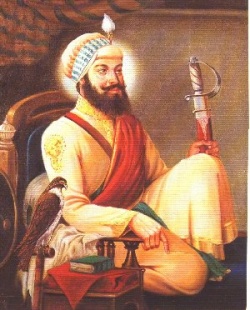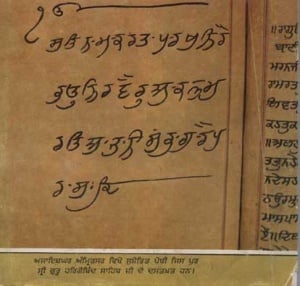Guru Har Gobind: Difference between revisions
mNo edit summary |
|||
| Line 47: | Line 47: | ||
The Guru also established the art of singing martial songs like 'Vars', which were sung by the Dhadd-players in the court of Guru Sahib to inspire the Sikhs to rise to heroic heights. The playing of other war oriented instruments like the Nagara (war-drum), �Shankh� (conch), etc. | The Guru also established the art of singing martial songs like 'Vars', which were sung by the Dhadd-players in the court of Guru Sahib to inspire the Sikhs to rise to heroic heights. The playing of other war oriented instruments like the Nagara (war-drum), �Shankh� (conch), etc. | ||
From Amritsar he went to Lahore where Kaulan, daughter of Kazi Rustam Khan and a follower of Sayin Miyan Mir came into his contact. She shifted to Amritsar and led a pious life there. On Guru Ji�s command, Baba Budha Ji had Gurudwara Kaulsar built in Kaulan�s memory in 1681 of Bikrami calendar. On the invitation of Sikhs he travelled to central India and had Gurudwara Nanak Matta completed there. Later he visited Kashmir and secured many followers there. He returned to Punjab via Gujrat. In reply to the four questions of Jehangir, disciple of Shah Tola, Guru Ji had said: | |||
1.The woman is the honour of a man | |||
2. A son is the mark of a man | |||
3. Money is transient | |||
4. A sage is neither a Hindu nor a Moslem | |||
Guru Hargobind Sahib fought four battles in his lifetime. Emperor Jehangir died in 1684 Bikrami and his son Shahjehan ascended the throne. The ill-wishers renewed their conspiracies and incited him too against Guru Ji. Otherwise also Shahjehan was insecure about the increasing influence and power of Sikhs. Sikhs trapped a falcon belonging to Shahjehan and a conflict with imperial bandits ensued. On the 22 day of Jeth month in Bikrami 1685, Sikhs won this battle. After winning it, Guru Ji married off Bibi Veero. In 1687 a battle was fought near village Ruhela where Moslem army and Turk chieftains were defeated. Guru Ji renamed this village as Hargobindpur. The third battle started when Bidhi Chand stole Guru Ji�s horses from Lahore fort; this battle too was won. The fourth battle took place near Kartarpur with Said Khan in Bikrami 1691. Lahore province was on Said Khan�s side. Said Khan and his fellow chieftains were killed and the Guru�s army won the battle. In 1701 Bikrami Guru Ji called his followers and passed on the mantle to his grandson Sri Har Rai Ji in their presence. The very same evening he passed away .It was the third day of March in year 1644. | |||
{{Sikh Gurus|Guru Arjan Dev|([[15 April]] [[1563]] - [[30 May]] [[1606]])|Guru Hargobind|Guru Har Rai|([[26 February]] [[1630]] - [[30 May]] [[1661]])}} | {{Sikh Gurus|Guru Arjan Dev|([[15 April]] [[1563]] - [[30 May]] [[1606]])|Guru Hargobind|Guru Har Rai|([[26 February]] [[1630]] - [[30 May]] [[1661]])}} | ||
Revision as of 04:04, 23 June 2007
| Guru Har Gobind (1595 to 1644) | |
| Full Name : | Har Gobind |
| Personal Details | |
| Birth : | 19 June 1595, Guru ki Vadali in Dist. Amritsar |
| Guruship : | 11 June 1606 |
| Joti Jot : | 03 March 1644 |
| Family | |
| Parents : | Guru Arjan Dev & Mata Ganga |
| Brother/Sisters : | -N.A- |
| Spouse : | Mata Nanaki, Mata Mahadevi,Mata Damodari |
| Children : | Sons - Baba Gurditta, Baba Suraj Mal, Baba Ani Rai, Baba Atal Rai & Guru Tegh Bahadur Daughter - Bibi Biro |
| Other Details | |
| Bani in GGS: | {{{Bani in GGS}}} |
| Other Info: | Built the Akal Takhat, First Guru to engage in warfare, Main battles fought: Amritsar, Sri Hargobindpur, Guru Sar Marajh and Kartarpur |
Guru Har Gobind Ji (ਗਰੂ ਹਰਿ ਗੋਬਿੰਦ) (19 June 1595 - 03 March 1644) was the sixth of the Ten Gurus of Sikhism and became Guru on 11 June 1606 following in the footsteps of his father Guru Arjan Dev Ji. Before Guru Ji died, he nominated Guru Har Rai Ji, his grandson as the next Guru of the Sikhs. The following is a summary of the main highlights of Guru Ji's life:
- Transformed the Sikh fraternity by introducing martial arts and weapons for the defence of the masses following his father's martyrdom
- Militarised the Sikh movement. Carried 2 swords of Miri and Piri
- Built the Akal Takhat in 1608 - which is now one of five Takhats (Seat of Power) of the Sikhs
- Founded the city of Kiratpur in District Jalandhar, Punjab
- Guruji was imprisoned in the fort of Gwalior for one year and on release insisted that the other 52 fellow prisoners be freed as well.
- To mark this occasion the Sikhs celebrate Diwali
- First Guru to engage in warfare
- Fought 4 battles with the Mughal rulers
- Place of Birth: Guru ki Vadali in Dist. Amritsar
- Family: Parents: Father - Guru Arjan Dev Sahib Ji, Mother - Mata Ganga Devi Ji
- Guru ke Mahal (Wife): Mata Nanaki Ji
- Children: Shibazade- Baba Gurditta, Baba Suraj Mal, Baba Ani Rai, Baba Atal Rai, & Tegh Bahadur
- Sahibazadi - Bibi Biro
Detailed Account
Guru Hargobind was the sixth Sikh Guru. He was born at village Guru Ki Wadali in district Amritsar on 19 June, 1595 and was the only son of Mata Ganga and Guru Arjan, whom he succeeded in 1606 at the age of only 11 years old.
The young Hargobind received his early education and training from the revered Sikhs leaders of the time Baba Buddha and Bhai Gurdas. Guru Hargobind was married in about 1610 to Mata Nanaki also known as Mata Marwahi or Mata Mahadevi. They were endowed by a large family of one daughter Bibi Viro ji and five sons - Baba Gurditta, Suraj Mal ji, Ani Rai ji, Atal Rai ji and Tegh Bahadar ji.
On the 11 June 1606, young Hargobind became the sixth Sikh Guru at the tender age of 11. After the martyrdom of Guru Arjan Sahib, the Sikh Dharma experienced a marked change in direction. Until 1606, the Panth (group, nation) had been predominantly made up of unarmed religious followers, who relied on the local government and ruler for their defence and worldly protection. The main mission of the Panth was to concentrate on Spiritual awareness, improvement and implementation. On becoming Guru, the sixth master asked Baba Buddha ji for TWO kirpans and wore these on each side. Maharaj announced that from now on, the Sikh mission will advance on two fronts simultaneously and that these two kirpans of Miri and Piri represented this concept. Miri for Military Power and Piri standing for Spiritual Power. It was due to the tragic martyrdom of his father, Guru Arjan that his son, the sixth Guru changed the Panth into an effective, brave and determined army of religious supporters.
From this time onwards, the Sikhs progressively took responsibility for their own worldly protection, the protection of their other followers, their immediate neighbour and any other weak person who was been attacked by an aggressor and asked for assistance. For the first time, the Sikhs became an army ready to challenge the mighty Mughal Empire in protecting the non-Muslim masses from the atrocities being committed by the fanatical rulers. Now the Sikh nation adopts both spiritual and political traditions simultaneously and the dual responsibilities were symbolised by the two kirpans of "Miri & Piri" worn by the sixth master.
It is documented in historical literature of the time that the Guru kept several hundred cavalier and some sixty artillerymen. Painda Khan was made the chief of a group of special band of Pathan mercenaries who represented the Guru Special armed forces. Guru asked the Sangat (Followers) for weapons, horses and other items of weaponry so that a credible army could be assembled. He also established martial and fitness-building sports so that the masses would be able to serve in these armed divisions as and when required. Gatka, wrestling, hunting were practised during this period. Many thousands of Sikhs took part in these exercises and announced their intention to defend their Panth from the barbaric Mughal and other aggressors.
The Guru also established the art of singing martial songs like 'Vars', which were sung by the Dhadd-players in the court of Guru Sahib to inspire the Sikhs to rise to heroic heights. The playing of other war oriented instruments like the Nagara (war-drum), �Shankh� (conch), etc.
From Amritsar he went to Lahore where Kaulan, daughter of Kazi Rustam Khan and a follower of Sayin Miyan Mir came into his contact. She shifted to Amritsar and led a pious life there. On Guru Ji�s command, Baba Budha Ji had Gurudwara Kaulsar built in Kaulan�s memory in 1681 of Bikrami calendar. On the invitation of Sikhs he travelled to central India and had Gurudwara Nanak Matta completed there. Later he visited Kashmir and secured many followers there. He returned to Punjab via Gujrat. In reply to the four questions of Jehangir, disciple of Shah Tola, Guru Ji had said:
1.The woman is the honour of a man
2. A son is the mark of a man
3. Money is transient
4. A sage is neither a Hindu nor a Moslem
Guru Hargobind Sahib fought four battles in his lifetime. Emperor Jehangir died in 1684 Bikrami and his son Shahjehan ascended the throne. The ill-wishers renewed their conspiracies and incited him too against Guru Ji. Otherwise also Shahjehan was insecure about the increasing influence and power of Sikhs. Sikhs trapped a falcon belonging to Shahjehan and a conflict with imperial bandits ensued. On the 22 day of Jeth month in Bikrami 1685, Sikhs won this battle. After winning it, Guru Ji married off Bibi Veero. In 1687 a battle was fought near village Ruhela where Moslem army and Turk chieftains were defeated. Guru Ji renamed this village as Hargobindpur. The third battle started when Bidhi Chand stole Guru Ji�s horses from Lahore fort; this battle too was won. The fourth battle took place near Kartarpur with Said Khan in Bikrami 1691. Lahore province was on Said Khan�s side. Said Khan and his fellow chieftains were killed and the Guru�s army won the battle. In 1701 Bikrami Guru Ji called his followers and passed on the mantle to his grandson Sri Har Rai Ji in their presence. The very same evening he passed away .It was the third day of March in year 1644.
| Preceded by: Guru Arjan Dev (15 April 1563 - 30 May 1606) |
Guru Hargobind | Followed by: Guru Har Rai (26 February 1630 - 30 May 1661) |
| These are the Ten Gurus of Sikhism |
|
Guru Nanak | Guru Angad Dev | Guru Amar Das | Guru Ram Das | Guru Arjan | Guru Hargobind | Guru Har Rai | Guru Har Krishan | Guru Teg Bahadur | Guru Gobind Singh |
External Links
Audio: Sukhmani Sahib Mp3,Real Audio, Real Audio download


